Managing Food Production
VerifiedAdded on 2022/11/25
|8
|1552
|220
AI Summary
This document discusses the management of food production, including types of food preparation, influences on the system, and a comparison of food preparation and production systems. It also provides insights on food production systems and their impact on food quality, expenditure, and customer preferences.
Contribute Materials
Your contribution can guide someone’s learning journey. Share your
documents today.
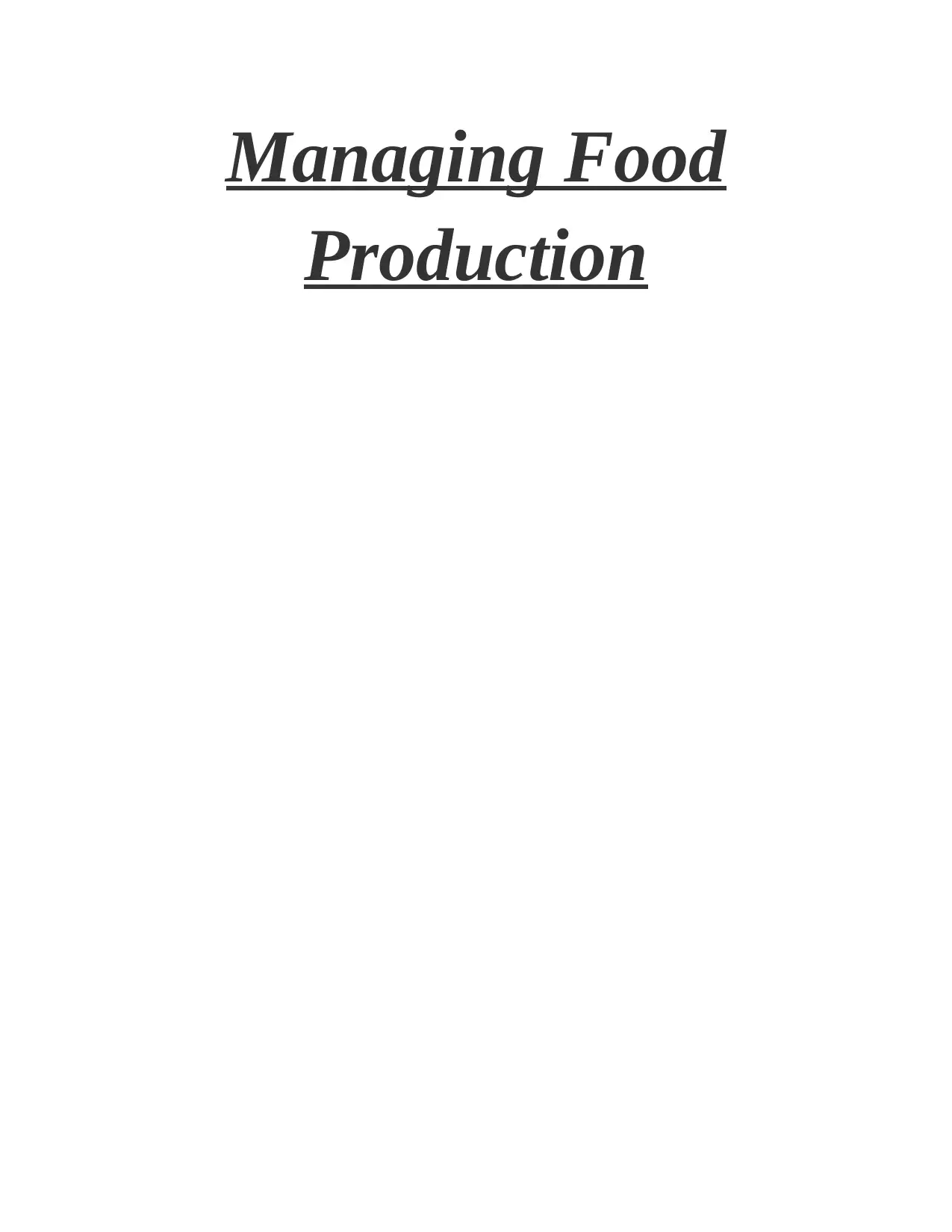
Managing Food
Production
Production
Secure Best Marks with AI Grader
Need help grading? Try our AI Grader for instant feedback on your assignments.
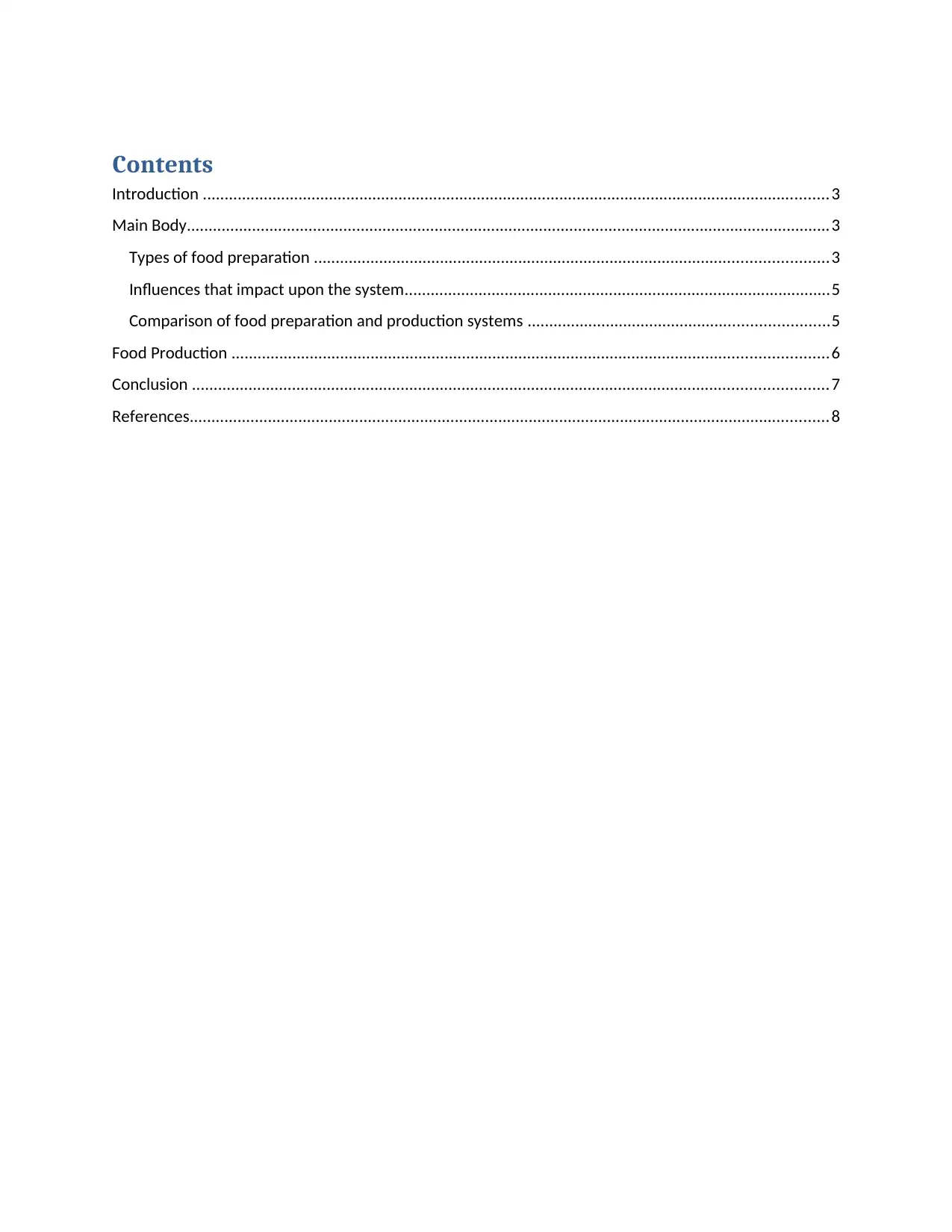
Contents
Introduction ................................................................................................................................................3
Main Body....................................................................................................................................................3
Types of food preparation ......................................................................................................................3
Influences that impact upon the system..................................................................................................5
Comparison of food preparation and production systems .....................................................................5
Food Production .........................................................................................................................................6
Conclusion ..................................................................................................................................................7
References...................................................................................................................................................8
Introduction ................................................................................................................................................3
Main Body....................................................................................................................................................3
Types of food preparation ......................................................................................................................3
Influences that impact upon the system..................................................................................................5
Comparison of food preparation and production systems .....................................................................5
Food Production .........................................................................................................................................6
Conclusion ..................................................................................................................................................7
References...................................................................................................................................................8

Introduction
Management of food production highlights upon the process and procedures according to which
the food production process is conducted, managed , administered and monitored in a particular
setting. The effective management of food production is very crucial in order to run a profitable
food ventures and outlets in the concerned industry. The report reflects upon the diverse types in
which food is prepared and produced. Along with this, relevant insights relating to the
influencing factors while designing food preparation and production systems is also
demonstrated within the report. Moreover, the report also discusses the necessary contrasts
between the various food production and preparation systems and methods.
Main Body
Types of food preparation
Emulsification
It can be termed as a method through which two ingredient or materials with diversifying
properties such as oil and water are combined together (Huyard, 2020). It results in a semi stable
mixture. For instance ice- creams, whipped cream etc.
Baking
It is a method preparation wherein food is prepared through the utilization of dry heat and
convenient temperatures. Cakes, breads, cookies, pizzas etc. are few of the food items prepared
through the particular food production approach.
Frying
The use heating oil in order to facilitate regulated heat to cook a particular food item is known as
frying method. In involves deep, stir, pan frying etc. For instance, French fries, fried rice etc. are
cooked through frying mode.
Steam
Management of food production highlights upon the process and procedures according to which
the food production process is conducted, managed , administered and monitored in a particular
setting. The effective management of food production is very crucial in order to run a profitable
food ventures and outlets in the concerned industry. The report reflects upon the diverse types in
which food is prepared and produced. Along with this, relevant insights relating to the
influencing factors while designing food preparation and production systems is also
demonstrated within the report. Moreover, the report also discusses the necessary contrasts
between the various food production and preparation systems and methods.
Main Body
Types of food preparation
Emulsification
It can be termed as a method through which two ingredient or materials with diversifying
properties such as oil and water are combined together (Huyard, 2020). It results in a semi stable
mixture. For instance ice- creams, whipped cream etc.
Baking
It is a method preparation wherein food is prepared through the utilization of dry heat and
convenient temperatures. Cakes, breads, cookies, pizzas etc. are few of the food items prepared
through the particular food production approach.
Frying
The use heating oil in order to facilitate regulated heat to cook a particular food item is known as
frying method. In involves deep, stir, pan frying etc. For instance, French fries, fried rice etc. are
cooked through frying mode.
Steam
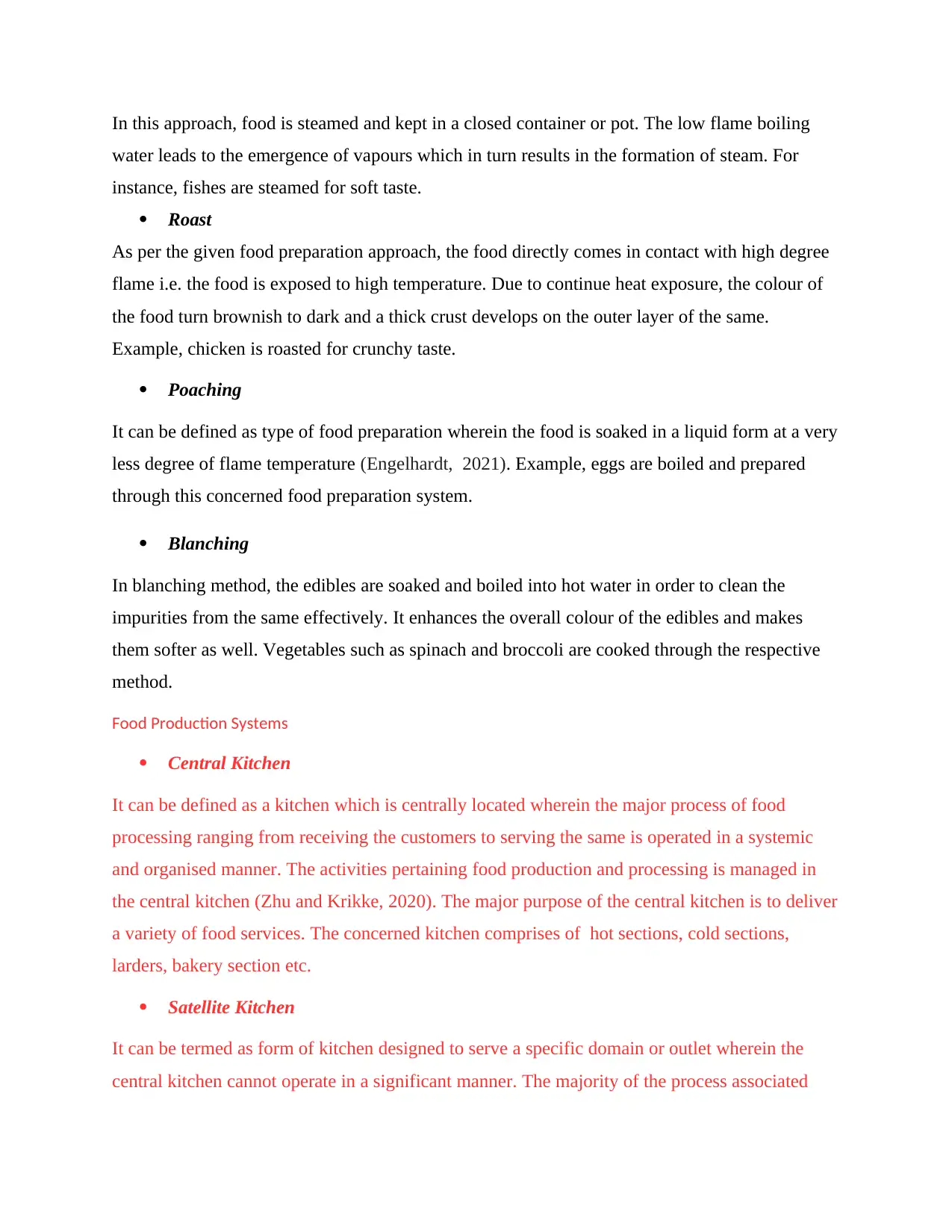
In this approach, food is steamed and kept in a closed container or pot. The low flame boiling
water leads to the emergence of vapours which in turn results in the formation of steam. For
instance, fishes are steamed for soft taste.
Roast
As per the given food preparation approach, the food directly comes in contact with high degree
flame i.e. the food is exposed to high temperature. Due to continue heat exposure, the colour of
the food turn brownish to dark and a thick crust develops on the outer layer of the same.
Example, chicken is roasted for crunchy taste.
Poaching
It can be defined as type of food preparation wherein the food is soaked in a liquid form at a very
less degree of flame temperature (Engelhardt, 2021). Example, eggs are boiled and prepared
through this concerned food preparation system.
Blanching
In blanching method, the edibles are soaked and boiled into hot water in order to clean the
impurities from the same effectively. It enhances the overall colour of the edibles and makes
them softer as well. Vegetables such as spinach and broccoli are cooked through the respective
method.
Food Production Systems
Central Kitchen
It can be defined as a kitchen which is centrally located wherein the major process of food
processing ranging from receiving the customers to serving the same is operated in a systemic
and organised manner. The activities pertaining food production and processing is managed in
the central kitchen (Zhu and Krikke, 2020). The major purpose of the central kitchen is to deliver
a variety of food services. The concerned kitchen comprises of hot sections, cold sections,
larders, bakery section etc.
Satellite Kitchen
It can be termed as form of kitchen designed to serve a specific domain or outlet wherein the
central kitchen cannot operate in a significant manner. The majority of the process associated
water leads to the emergence of vapours which in turn results in the formation of steam. For
instance, fishes are steamed for soft taste.
Roast
As per the given food preparation approach, the food directly comes in contact with high degree
flame i.e. the food is exposed to high temperature. Due to continue heat exposure, the colour of
the food turn brownish to dark and a thick crust develops on the outer layer of the same.
Example, chicken is roasted for crunchy taste.
Poaching
It can be defined as type of food preparation wherein the food is soaked in a liquid form at a very
less degree of flame temperature (Engelhardt, 2021). Example, eggs are boiled and prepared
through this concerned food preparation system.
Blanching
In blanching method, the edibles are soaked and boiled into hot water in order to clean the
impurities from the same effectively. It enhances the overall colour of the edibles and makes
them softer as well. Vegetables such as spinach and broccoli are cooked through the respective
method.
Food Production Systems
Central Kitchen
It can be defined as a kitchen which is centrally located wherein the major process of food
processing ranging from receiving the customers to serving the same is operated in a systemic
and organised manner. The activities pertaining food production and processing is managed in
the central kitchen (Zhu and Krikke, 2020). The major purpose of the central kitchen is to deliver
a variety of food services. The concerned kitchen comprises of hot sections, cold sections,
larders, bakery section etc.
Satellite Kitchen
It can be termed as form of kitchen designed to serve a specific domain or outlet wherein the
central kitchen cannot operate in a significant manner. The majority of the process associated
Secure Best Marks with AI Grader
Need help grading? Try our AI Grader for instant feedback on your assignments.
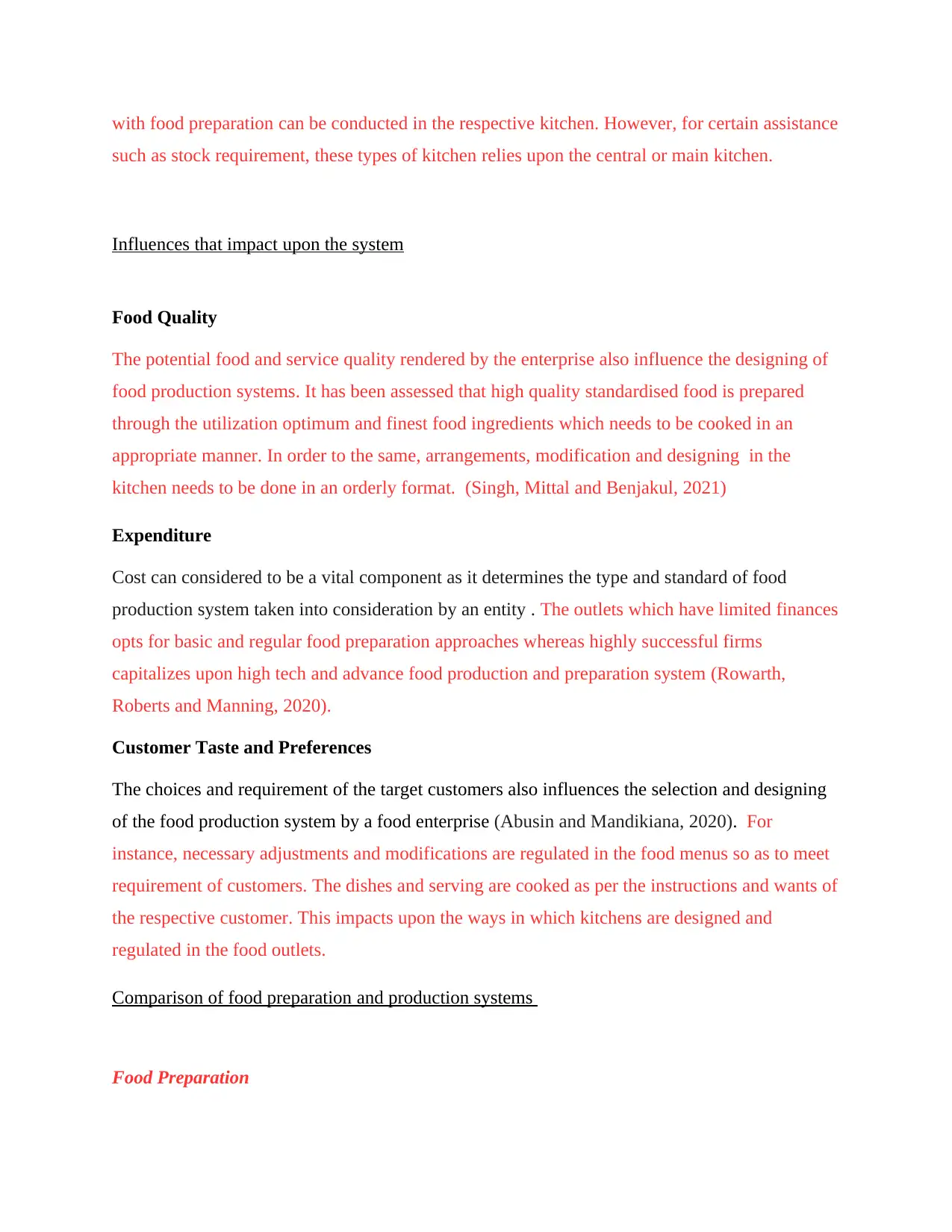
with food preparation can be conducted in the respective kitchen. However, for certain assistance
such as stock requirement, these types of kitchen relies upon the central or main kitchen.
Influences that impact upon the system
Food Quality
The potential food and service quality rendered by the enterprise also influence the designing of
food production systems. It has been assessed that high quality standardised food is prepared
through the utilization optimum and finest food ingredients which needs to be cooked in an
appropriate manner. In order to the same, arrangements, modification and designing in the
kitchen needs to be done in an orderly format. (Singh, Mittal and Benjakul, 2021)
Expenditure
Cost can considered to be a vital component as it determines the type and standard of food
production system taken into consideration by an entity . The outlets which have limited finances
opts for basic and regular food preparation approaches whereas highly successful firms
capitalizes upon high tech and advance food production and preparation system (Rowarth,
Roberts and Manning, 2020).
Customer Taste and Preferences
The choices and requirement of the target customers also influences the selection and designing
of the food production system by a food enterprise (Abusin and Mandikiana, 2020). For
instance, necessary adjustments and modifications are regulated in the food menus so as to meet
requirement of customers. The dishes and serving are cooked as per the instructions and wants of
the respective customer. This impacts upon the ways in which kitchens are designed and
regulated in the food outlets.
Comparison of food preparation and production systems
Food Preparation
such as stock requirement, these types of kitchen relies upon the central or main kitchen.
Influences that impact upon the system
Food Quality
The potential food and service quality rendered by the enterprise also influence the designing of
food production systems. It has been assessed that high quality standardised food is prepared
through the utilization optimum and finest food ingredients which needs to be cooked in an
appropriate manner. In order to the same, arrangements, modification and designing in the
kitchen needs to be done in an orderly format. (Singh, Mittal and Benjakul, 2021)
Expenditure
Cost can considered to be a vital component as it determines the type and standard of food
production system taken into consideration by an entity . The outlets which have limited finances
opts for basic and regular food preparation approaches whereas highly successful firms
capitalizes upon high tech and advance food production and preparation system (Rowarth,
Roberts and Manning, 2020).
Customer Taste and Preferences
The choices and requirement of the target customers also influences the selection and designing
of the food production system by a food enterprise (Abusin and Mandikiana, 2020). For
instance, necessary adjustments and modifications are regulated in the food menus so as to meet
requirement of customers. The dishes and serving are cooked as per the instructions and wants of
the respective customer. This impacts upon the ways in which kitchens are designed and
regulated in the food outlets.
Comparison of food preparation and production systems
Food Preparation
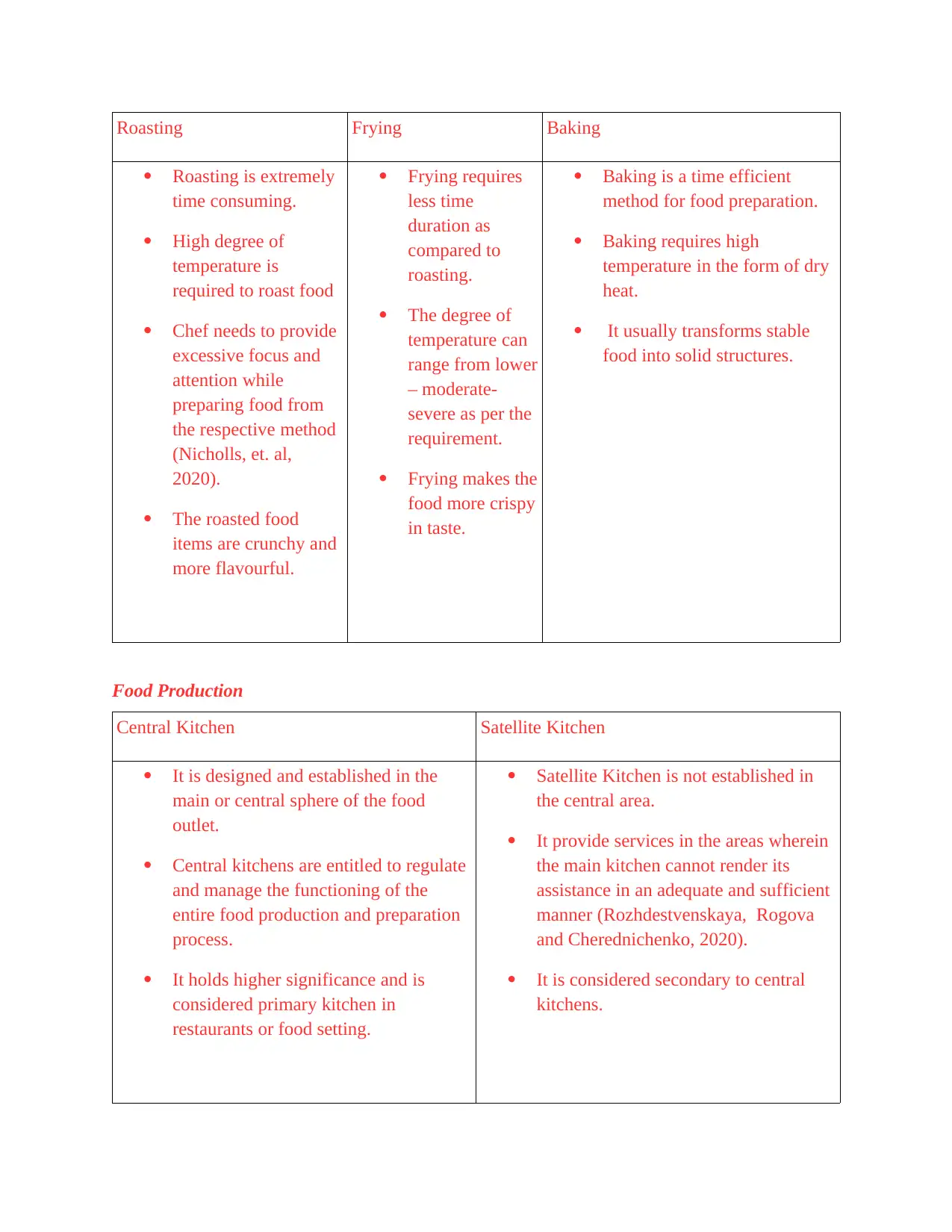
Roasting Frying Baking
Roasting is extremely
time consuming.
High degree of
temperature is
required to roast food
Chef needs to provide
excessive focus and
attention while
preparing food from
the respective method
(Nicholls, et. al,
2020).
The roasted food
items are crunchy and
more flavourful.
Frying requires
less time
duration as
compared to
roasting.
The degree of
temperature can
range from lower
– moderate-
severe as per the
requirement.
Frying makes the
food more crispy
in taste.
Baking is a time efficient
method for food preparation.
Baking requires high
temperature in the form of dry
heat.
It usually transforms stable
food into solid structures.
Food Production
Central Kitchen Satellite Kitchen
It is designed and established in the
main or central sphere of the food
outlet.
Central kitchens are entitled to regulate
and manage the functioning of the
entire food production and preparation
process.
It holds higher significance and is
considered primary kitchen in
restaurants or food setting.
Satellite Kitchen is not established in
the central area.
It provide services in the areas wherein
the main kitchen cannot render its
assistance in an adequate and sufficient
manner (Rozhdestvenskaya, Rogova
and Cherednichenko, 2020).
It is considered secondary to central
kitchens.
Roasting is extremely
time consuming.
High degree of
temperature is
required to roast food
Chef needs to provide
excessive focus and
attention while
preparing food from
the respective method
(Nicholls, et. al,
2020).
The roasted food
items are crunchy and
more flavourful.
Frying requires
less time
duration as
compared to
roasting.
The degree of
temperature can
range from lower
– moderate-
severe as per the
requirement.
Frying makes the
food more crispy
in taste.
Baking is a time efficient
method for food preparation.
Baking requires high
temperature in the form of dry
heat.
It usually transforms stable
food into solid structures.
Food Production
Central Kitchen Satellite Kitchen
It is designed and established in the
main or central sphere of the food
outlet.
Central kitchens are entitled to regulate
and manage the functioning of the
entire food production and preparation
process.
It holds higher significance and is
considered primary kitchen in
restaurants or food setting.
Satellite Kitchen is not established in
the central area.
It provide services in the areas wherein
the main kitchen cannot render its
assistance in an adequate and sufficient
manner (Rozhdestvenskaya, Rogova
and Cherednichenko, 2020).
It is considered secondary to central
kitchens.
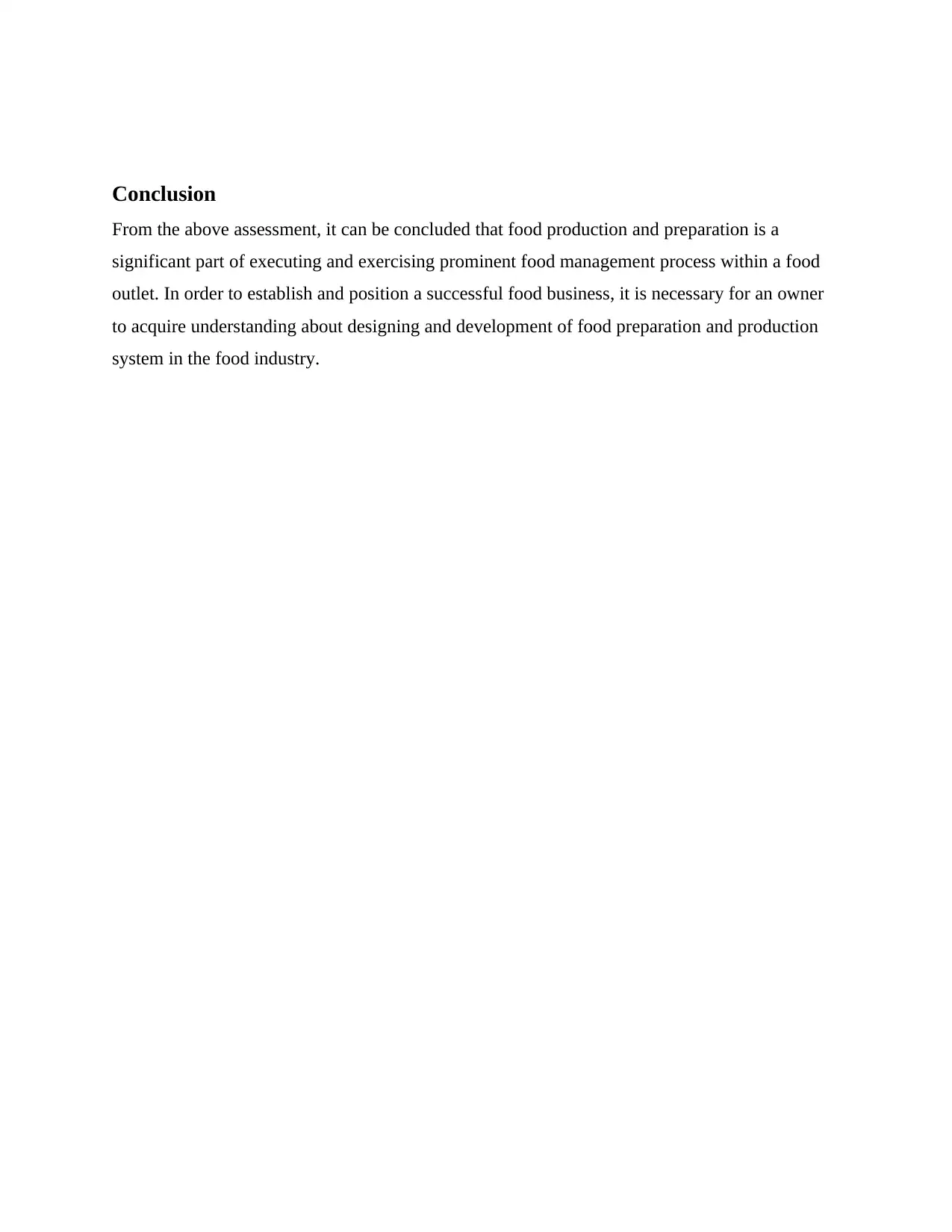
Conclusion
From the above assessment, it can be concluded that food production and preparation is a
significant part of executing and exercising prominent food management process within a food
outlet. In order to establish and position a successful food business, it is necessary for an owner
to acquire understanding about designing and development of food preparation and production
system in the food industry.
From the above assessment, it can be concluded that food production and preparation is a
significant part of executing and exercising prominent food management process within a food
outlet. In order to establish and position a successful food business, it is necessary for an owner
to acquire understanding about designing and development of food preparation and production
system in the food industry.
Paraphrase This Document
Need a fresh take? Get an instant paraphrase of this document with our AI Paraphraser
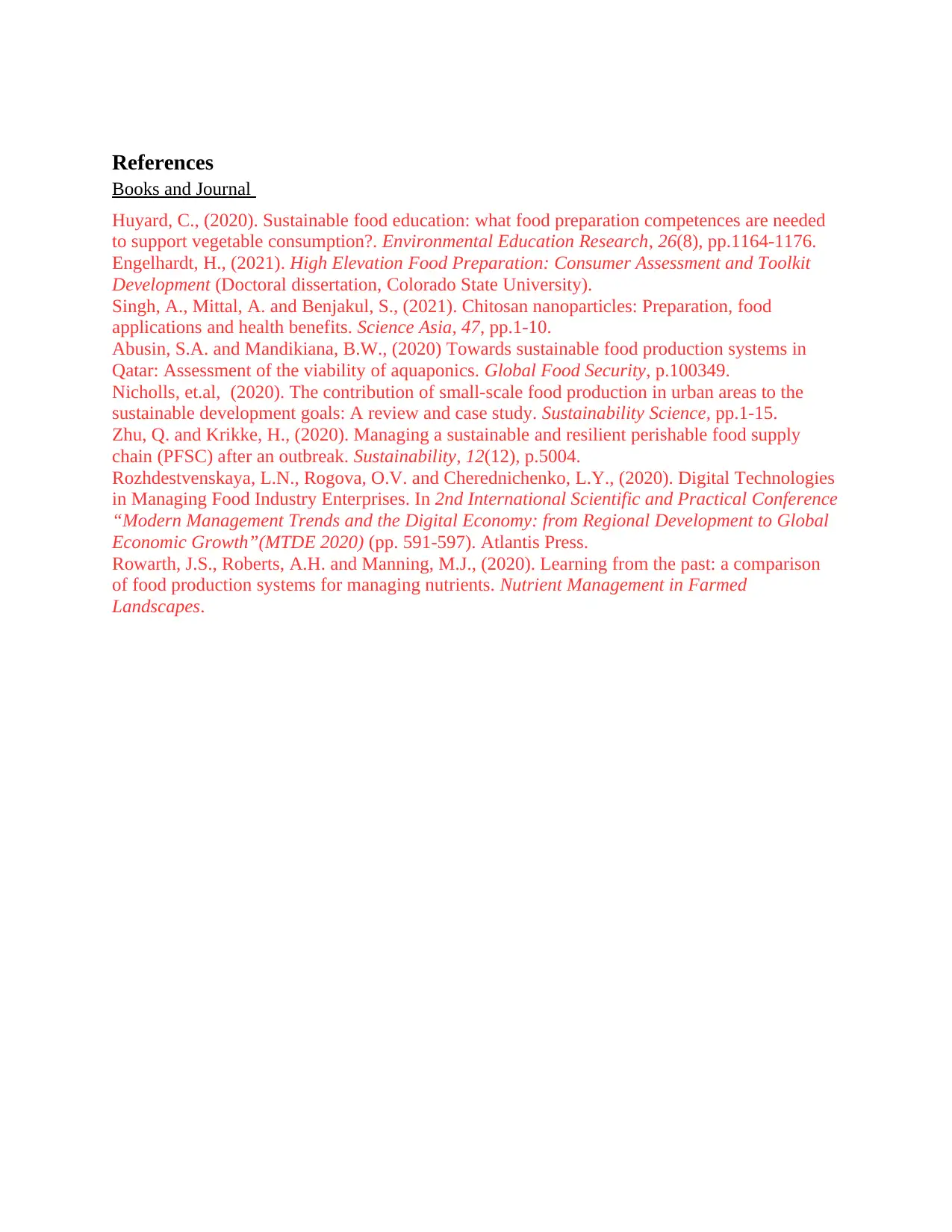
References
Books and Journal
Huyard, C., (2020). Sustainable food education: what food preparation competences are needed
to support vegetable consumption?. Environmental Education Research, 26(8), pp.1164-1176.
Engelhardt, H., (2021). High Elevation Food Preparation: Consumer Assessment and Toolkit
Development (Doctoral dissertation, Colorado State University).
Singh, A., Mittal, A. and Benjakul, S., (2021). Chitosan nanoparticles: Preparation, food
applications and health benefits. Science Asia, 47, pp.1-10.
Abusin, S.A. and Mandikiana, B.W., (2020) Towards sustainable food production systems in
Qatar: Assessment of the viability of aquaponics. Global Food Security, p.100349.
Nicholls, et.al, (2020). The contribution of small-scale food production in urban areas to the
sustainable development goals: A review and case study. Sustainability Science, pp.1-15.
Zhu, Q. and Krikke, H., (2020). Managing a sustainable and resilient perishable food supply
chain (PFSC) after an outbreak. Sustainability, 12(12), p.5004.
Rozhdestvenskaya, L.N., Rogova, O.V. and Cherednichenko, L.Y., (2020). Digital Technologies
in Managing Food Industry Enterprises. In 2nd International Scientific and Practical Conference
“Modern Management Trends and the Digital Economy: from Regional Development to Global
Economic Growth”(MTDE 2020) (pp. 591-597). Atlantis Press.
Rowarth, J.S., Roberts, A.H. and Manning, M.J., (2020). Learning from the past: a comparison
of food production systems for managing nutrients. Nutrient Management in Farmed
Landscapes.
Books and Journal
Huyard, C., (2020). Sustainable food education: what food preparation competences are needed
to support vegetable consumption?. Environmental Education Research, 26(8), pp.1164-1176.
Engelhardt, H., (2021). High Elevation Food Preparation: Consumer Assessment and Toolkit
Development (Doctoral dissertation, Colorado State University).
Singh, A., Mittal, A. and Benjakul, S., (2021). Chitosan nanoparticles: Preparation, food
applications and health benefits. Science Asia, 47, pp.1-10.
Abusin, S.A. and Mandikiana, B.W., (2020) Towards sustainable food production systems in
Qatar: Assessment of the viability of aquaponics. Global Food Security, p.100349.
Nicholls, et.al, (2020). The contribution of small-scale food production in urban areas to the
sustainable development goals: A review and case study. Sustainability Science, pp.1-15.
Zhu, Q. and Krikke, H., (2020). Managing a sustainable and resilient perishable food supply
chain (PFSC) after an outbreak. Sustainability, 12(12), p.5004.
Rozhdestvenskaya, L.N., Rogova, O.V. and Cherednichenko, L.Y., (2020). Digital Technologies
in Managing Food Industry Enterprises. In 2nd International Scientific and Practical Conference
“Modern Management Trends and the Digital Economy: from Regional Development to Global
Economic Growth”(MTDE 2020) (pp. 591-597). Atlantis Press.
Rowarth, J.S., Roberts, A.H. and Manning, M.J., (2020). Learning from the past: a comparison
of food production systems for managing nutrients. Nutrient Management in Farmed
Landscapes.
1 out of 8
Related Documents
Your All-in-One AI-Powered Toolkit for Academic Success.
+13062052269
info@desklib.com
Available 24*7 on WhatsApp / Email
![[object Object]](/_next/static/media/star-bottom.7253800d.svg)
Unlock your academic potential
© 2024 | Zucol Services PVT LTD | All rights reserved.





